Genre: Fighting Developer: Visual Concepts Publisher: Namco Players: 1-2 Released: 1995
The success of Street Fighter II, “success” being far too mild a word to describe that particular game’s impact on the industry and culture at large, netted numerous also-rans trying to make a buck off the fighting game craze. The main problem with most of these copy cats was that the developers focused more on creating a gimmick to stand out from the crowd with the actual gameplay being largely an afterthought. Thus, we have Time Killers (SFII with amputees), Mortal Kombat (digitized SFII with gore), Clay Fighters (Claymation SFII), Rise of the Robots (SFII with invalids), Primal Rage (Jurassic SFII), and so on and so forth as developers looked to cash in on Capcom’s mint. The sad thing is that despite some atrocious gameplay and control, many of these gimmicks paid off, leading to sequels and varying popularity.
WeaponLord did not fare so well, which is unfortunate since it is arguably the best fighting game available on the 16-bit consoles. Along with Ristar, Comix Zone, and other stellar releases late in the 16-bit era, WeaponLord appears to be more the victim of poor timing than anything else. Reviews were mixed, with the game garnering praise from GamePro (four exploding heads out of five) and getting trashed by Electronic Gaming Monthly (5.6 out of 10 and later dropped to 3 out of 10 thanks to a re-review by EGM’s 1Up for being a “sub-par Street Fighter clone with digitized voices, decent-sized sprites, and classically awful gameplay”). Namco’s own advertisements failed to deliver, burying its X-Band compatibility logo in the corner and leaving over three-quarters of WeaponLord’s two page spread with a bit of bland text announcing how the game has “redefine[d] the entire fighting game genre” thanks in large part to the “first aggressive blocking system ever.” Despite attempts by some DieHard GameFan writers to generate a buzz, WeaponLord’s lack of the shiny new polygons and 3D graphics people demanded with the advent of 32-bit systems led it to drown in the approaching next generation flood.
With Nick Rox and the rest of the world’s fighting game fans too busy drooling over Toshinden, the world remained largely oblivious that WeaponLord is an amazing and complex fighter worthy of attention regardless of its bit architecture. On first glance the game can be dismissed as Samurai Shodown in a fantasy setting, but that would overlook the depth of WeaponLord’s combat engine which includes the ability to break weapons, deflecting attacks, unblockable strikes, the aforementioned thrust “aggressive” blocking, and more. Combos can be extended by getting an opponent to stagger with a “double over” hit or by knocking them over with a “take down” move. Finally, WeaponLord features multiple special moves which double as (and can be combo-ed into) Mortal Kombat-style fatalities, allowing the victor to gut, behead, and otherwise defile the loser’s corpse without breaking the flow of the game. If that’s not enough humiliation, the game also lets players cut off clothing and hair during the match itself with a well-timed strike.
If that sounds ridiculously complex, it is, especially considering the competition at the time. Further adding to WeaponLord’s complexity was its use of Street Fighter II-style special moves (D-pad motion then button press) along with Primal Rage-type inputs (hold button, motion D-pad, then release). Each of the seven combatants in WeaponLord sports about ten or so special moves, with roughly half of them belonging to each input method. While fighting games of this complexity are common today, they also benefit from having a training mode, which WeaponLord lacks. Producer James Goddard (who created the character DeeJay in Capcom’s own Super Street Fighter II) has written that a training mode was one of the things left out due to time constraints. While I believe that’s not much of an issue today given that most modern players will be quicker to adapt to such complexities in gameplay and control, which was not the case back in 1995.
The computer AI can be rather aggressive, and players will struggle with the sluggishness of the controls. That’s not to say the fighters are unresponsive but dealing with the number of schizophrenic special move inputs and variety of situations WeaponLord throws at the player will make all but the most fanatic fighting game players’ heads spin. The game uses the standard six-button fighter control scheme, but with all six inputs devoted to various types of weapon slashes, thrusts, and strikes, the overall sameness of the attacks can make it difficult to comprehend how to approach the game. For the players who just want to dragon punch and fireball their way to victory without understanding that the fighting engine is not as fast nor as cross-up and throw heavy as Street Fighter II, WeaponLord will disappoint. WeaponLord is all about taking one of the seven Boris Vallejo characters and completely annihilating the opponent. Every one of the cast, including the three female fighters, are ripped and ready to slice and gut their way to victory.
Korr, the most Conan-like of the cast, is the closest to the game’s “Ryu” in that he is the first character listed, arguably the best character, and is one of the two who have multiple endings. Despite the added focus on Korr, every character has his or her strengths and weaknesses, with the “thrust blocking” parry system providing for the ultimate equalizer. The remaining cast – Bane, Divada, Jen-Tai, Talazia, Zorn, and Zarak – do well to retain some individuality despite the copycat fantasy world they inhabit. Bane is the token “big guy” among a game of big guys, Jen-Tai is a warrior queen, Divada is a sorceress, and so on. Each fighter has a back story and unique ending, but players must complete the game on the hardest difficulty setting to fully see it. This is made somewhat easier since WeaponLord gives out passwords at checkpoints, which is an odd and misguided addition to the fighting genre.
Another misfire is in having the boss character, Zarak, immediately playable from the start. It greatly diminishes his impact in the game. The DemonLord Zarak resembles a humanoid spider and possesses the game’s sole unique fatality, a move in which he encases his victim in a webbing cocoon (which can be further sliced in half). Despite the quality of the cast, the lack of quantity does mar the game, particularly one with such a late release. It can be a hard pill to swallow when WeaponLord’s chief competitor launched with twelve diverse and instantly identifiable characters and tacked on another four fighters with the release of Super Street Fighter II a year earlier. Sure, I’ll take quality over quantity, but SSFII had both. WeaponLord might look for a pass being the first entry in a series, but even among brand new entries the roster is lacking.
The graphics are also a letdown, particularly when compared to the SNES version. The Genesis game is just a port of the SNES title, one which started too late in the development cycle to take advantage of the system’s full blast processing power. This results in WeaponLord getting stuck with black health bars as seen with the first unreleased Genesis version of Street Fighter II instead of having the life meters seamlessly displayed over the play field. WeaponLord’s graphics were designed with the SNES in mind as the Genesis just can’t display the number of colors to match the detail the game tries to push. Though the fighters look good enough, the backgrounds take a hit and look muddy. The game attempts to use more realistic lighting effects instead of the dark circles found underneath most games’ fighters, but the shadow effects end up looking just weird with the way the zoom and jitter about. The animation ranges from decent to good – I love how Bane wraps his fingers around his mallet of doom when idle — and stellar art direction helps overlook some of the visual gaffs, but the lack of polish is apparent.
On the plus side, Visual Concepts was able to find the Genesis sound chip which so alluded Capcom’s programmers. The narrator and combatant voices are clear and audible – not as good as the SNES version, but a far cry better than Super Street Fighter II’s sound. Likewise, Brian Schmidt’s soundtrack does a decent job of keeping the theme with appropriate battle music, but the tracks are neither memorable nor tax the Genesis to the levels of other 1995 release games. There’s no more telling sign of quality or lack thereof when a game includes the option to turn off the background music, particularly when that option is not included with the superior SNES release.
WeaponLord is arguably the best fighter on a 16-bit console, but that console isn’t the Genesis. Though the gameplay holds up well even compared to modern fighters which is an impressive feat in itself, I suspect most will tire with the lack of characters and poor presentation when compared to Super Street Fighter II. That’s not to say there can be only one when it comes to fighting games but getting the most out of WeaponLord’s dizzying array of commands and strikes will take some serious commitment, which unfortunately I don’t see happening for most players willing to give the game a try.
SCORE: 8 out of 10

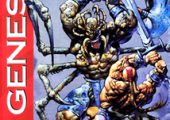
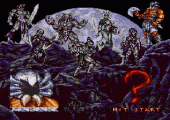
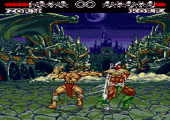
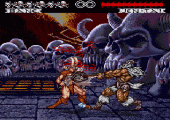
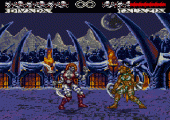
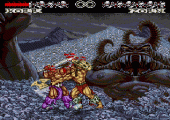
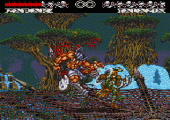
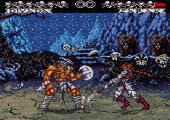
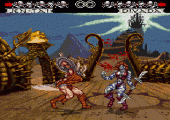
Weaponlord is indeed a great game, both in artistic terms (design of stages, and music) and a great game in terms of gameplay. I actually consider it better than Toshinden (which the author of the review mentioned) since it shows some gorgeous 16-bit graphics while at the time 3d technology was to say the least not quite advanced.
It is a pity it did not receice the cradit it deserved.
Here i may add that while the snes version looks and sounds better, the genesis one plays faster and without some of the glitches and lags the snes had. All in all, a great game and a very nice review!